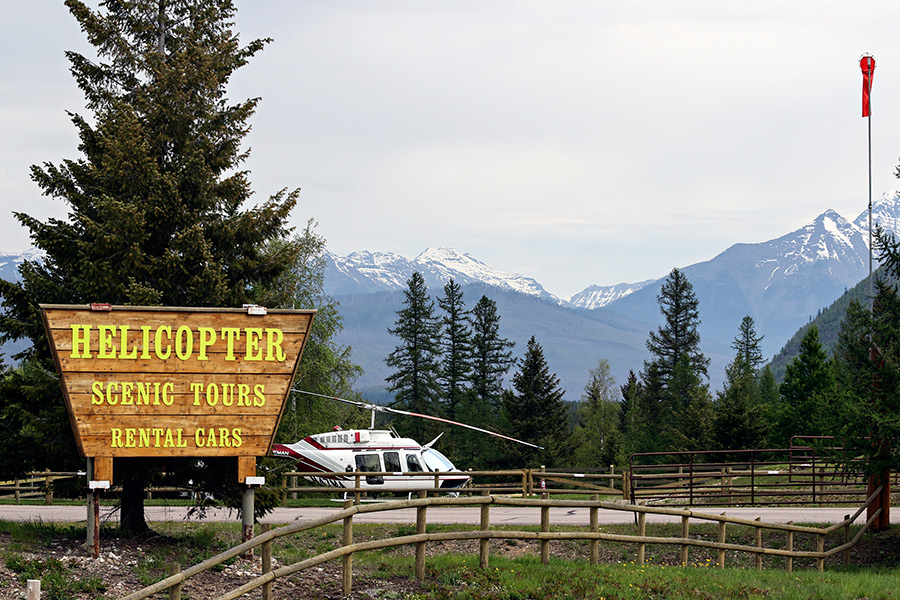Glacier Park Finalizes Plan to Phase Out Aerial Sightseeing Tours
After more than two decades navigating a jurisdictional gray area, the park has completed a plan to reduce noise pollution in the sky above its summits and end all commercial air tours by 2030
By Tristan Scott
Despite more than two decades of public pressure and a statutory mandate to restrict scenic air tours above Glacier National Park, the federal agencies charged with placing conditions on the intrusive overflights have remained in a sort of jurisdictional limbo.
Until now.
On Sept. 23, the National Park Service (NPS) and the Federal Aviation Administration (FAA) announced completion of a long-awaited Air Tour Management Plan (ATMP) for Glacier, including a provision “to phase out commercial air tours through attrition” by 2030, according to park officials, who added that the phaseout is consistent with Glacier’s General Management Plan and “has been and remains a priority management objective for the park.”
“The purpose of the air tour plan is to ensure that park resource values in Glacier National Park, including natural sounds, wilderness character, visitor experiences, wildlife, and other natural and cultural resources, are protected,” said Pete Webster, the park’s deputy superintendent.
Indeed, commercial air tours have occurred over Glacier National Park for many years without defined operating parameters. The proposed plan would authorize the three remaining commercial aerial sightseeing tour operators in Glacier — Minuteman Aviation, Red Eagle Aviation and Homestead Helicopters — to provide up to 144 air tours per year on defined routes, amounting to the three-year average total spanning 2017-2019, according to the plan, which authorizes the air tours to continue until they are “phased out through attrition or until 11:59 PM local time on December 31, 2029, when all operating authority for the Park will be terminated, whichever occurs first.”

A depiction of a commercial air route over Glacier National Park. Image courtesy of the National Park Service.
In order to phase out the air tours permanently and reduce the strain on noise-sensitive resources, as well as on the visitor experience, the agencies will not consider applications from “new entrant operators” and will not authorize commercial air tours by a successor to any of the three existing operators.
In determining the number of air tours allowable per year, the agencies opted against using data from 2020 and 2021 due to visitation abnormalities and irregularities associated with the Covid-19 pandemic.
The number of air tours allowed under the new plan represents a dramatic reduction from the 891 annual flights currently allowed over Glacier.
The operating parameters of the plan will be effective within 90 days from the date of signature on the air tour management plan.
The question of how to regulate commercial operations in the federally regulated air space above NPS units has been a challenging one to answer for the two federal agencies with shared jurisdictional authority but little else in common.
Glacier is among 24 parks in the National Park System for which the agencies are developing air tour management plans. The plans must meet the requirements from the National Parks Air Tour Management Act to mitigate or prevent significant adverse impacts from commercial air tours on the park and NPS’s obligation to protect the park’s natural and cultural resources, wildlife, and the visitor enjoyment.
Mary Riddle, the recently retired chief of planning and environmental compliance at Glacier Park, spent much of her career crafting a solution to quell noise pollution created by helicopter tours, beginning when the overflights emerged as a critical issue during development of the park’s General Management Plan in 1999. The helicopter tours create a disturbance not only to human visitors, eroding the quietude many seek in national parks, according to public comments, but they also stress wildlife.
“Of all the issues we tackled in the General Management Plan, scenic air tours received by far the highest number of comments, and over 95% of those comments wanted the air tours removed,” Riddle told the Beacon last year. “But the National Park Service does not have jurisdiction over that air space. It’s the only commercial activity taking place within the park’s boundaries that we do not manage under a concession-type contract, so we could not make a unilateral decision to prohibit them.”
With their hands tied, NPS administrators have abrogated authority to FAA; in doing so, the agency has remained out of compliance with the National Parks Air Tour Management Act of 2000, which requires the FAA, in coordination with the NPS, to set limits on overflight numbers, timing and routes to protect park resources and the visitor experience. In May 2020, fed up with the delays created by what he billed as an interagency “turf war,” a federal circuit court judge ordered the NPS and FAA to complete air tour management plans within the next two years.
“Left to their own devices, the agencies have failed to comply with their statutory mandate for the past 19 years,” D.C. Circuit Judge Thomas Griffith wrote in his May 2020 opinion. “We fully expect that the agencies will make every effort to produce a plan that will enable them to complete the task within two years, as Congress directed. If the agencies anticipate that it will take them more than two years, they must offer specific, concrete reasons for why that is so in their proposal.”
In ordering the FAA and NPS to produce a schedule for bringing 23 national parks, including Glacier National Park, into compliance with the Air Tour Management Act of 2000, Judge Griffith resolves a lawsuit brought by the Hawaii Island Coalition Malama Pono, or HICoP, and the Public Employees for Environmental Responsibility (PEER), which sought an injunction after the FAA and NPS failed to implement air tour management plans for Hawaii Volcanoes National Park and Haleakala National Park. Hawaii Volcanoes National Park and Haleakala National Park had, respectively, the most and fourth-most reported number of commercial air tours in the nation in 2018, according to a 2018 report from the NPS.